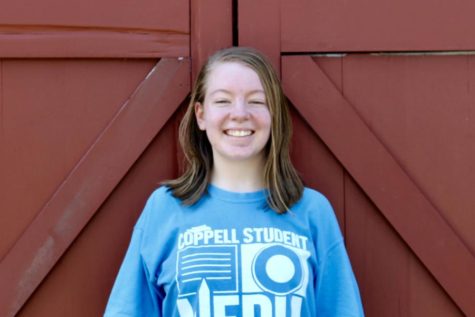Big things come in small packages
Barnes finds new lifestyle in tiny home
Coppell High school astronomy and earth space and space science teacher Angela Barnes in her tiny home’s kitchen, on Feb 2. Barnes has been living in her new home for about nine months to be more energy-efficient and reduce her carbon footprint.
February 3, 2020
You step inside your house, drop your backpack and head to your bedroom, ready to escape into the comfort of your bed. For average people, it might take a minute to get to their room, maybe a little less.
For Coppell High School astronomy and earth & space science teacher Angela Barnes, it takes only a couple seconds to travel through her tiny home, which she has been living in since July 2019.
“It all started when those TV shows and other media came out showing the tiny house trend and it was something I was interested in because I am really into living sustainably,” Barnes said. “To be honest, I’m not from Dallas and there’s a part of me that just had a problem buying a house here and permanently settling here, and to buy a house that’s on wheels just made more sense for me.”
Tiny houses are commonly defined as a house ranging from 100 to 400 square feet. In recent years, with the sustainability movement growing traction, so have tiny houses, with tiny houses being naturally green. According to the National Association of Homebuilders, more than 53% of Americans would consider living in a tiny house. An estimate of 10,000 tiny houses are currently the United States and in 2017, sales of tiny houses increased by 67%.
The reasons for this choice vary, but commonly cited is that they reduce carbon impact, foster a more minimalist lifestyle and lower cost.
“I knew having a tiny house and a smaller footprint would, for financial reasons, be more beneficial,” said neighbor Carl Pigg, who also lives in a tiny house.
Energy and water consumption are significantly less in a tiny home, leading to both lowering one’s bills and helping the climate.
For Barnes, the transition to a tiny house came as a transition to a new life.
“I went from being married and living in a large four-bedroom house with a pool and gameroom, [to] post-divorce, moved to a one-bedroom apartment, which, after a few years I realized was even too much space for just me, and I ended up having things I didn’t use and closets full of stuff,” Barnes said. “I started seeing tiny houses on my way to work in an RV park and I thought, ‘Oh, I want to live there too.’”
A lot of people assume living in a tiny house can induce claustrophobia or be uncomfortable, but many tiny house owners disagree.
“One of the misconceptions of a tiny house is that people always [say], ‘Oh, you can live in a small space because you’re going to spend so much time outdoors,’ but I love being in my house,” Barnes’ neighbor Erica Jawett Hirst said. “It’s very comfortable, and I love coming home and being with my dogs. I don’t ever feel like I’m claustrophobic here.”
The only challenge Barnes faces is adjusting to hosting friends.
“I’d love to build a deck off the side so I have some space when I have people over, because it’s been a little bit challenging having more than one or two people at a time, [and] I like to entertain,” Barnes said.
The best aspect of her home for Barnes is the liberty it provides her.
“I love it,” Barnes said. “It’s so organized and tiny and really modern-looking and I’m very comfortable in it, I feel safe in it. Everything I own has a place, and for me, it’s just perfect. I don’t need anything more. [Living in a tiny house] gives me stability and also some freedom, too.”
Follow Claire (@cclements825) and @CHSCampusNews on Twitter.












